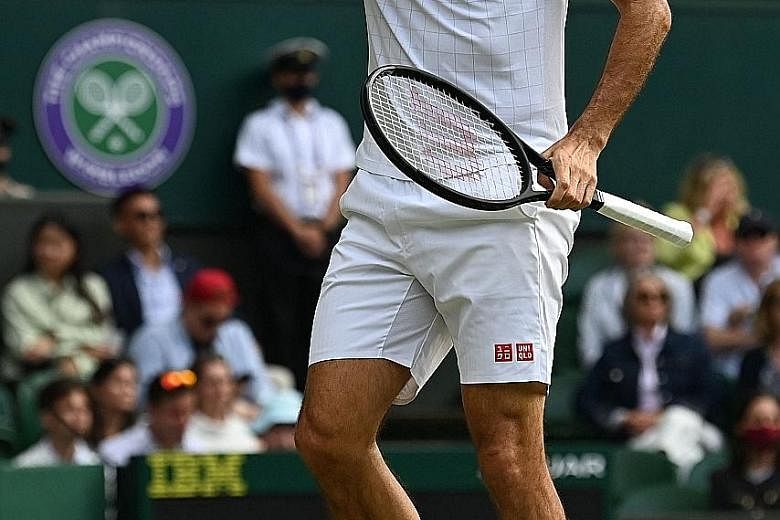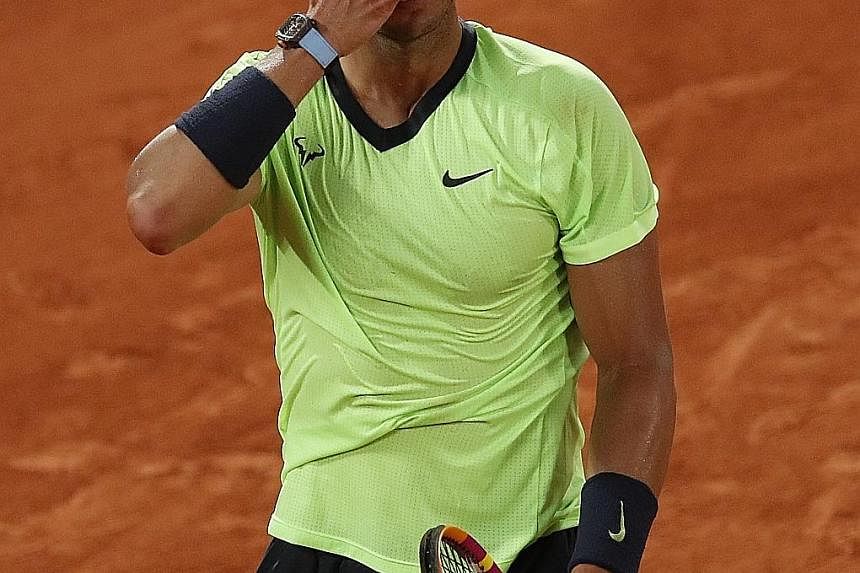WIMBLEDON • The Big Three now have 20 apiece.
It is a development that would have seemed unlikely to Novak Djokovic as he made his way onto the tour in the aughts with Roger Federer and Rafael Nadal racking up Grand Slam singles titles.
Federer was entrenched at No. 1 and had found his groove after an up-and-down start. Nadal, a genuine prodigy, was already all but unbeatable on clay courts in his teens and would soon challenge Federer on every surface.
They were a duopoly, the dominant topic in men's tennis for good reason. Djokovic was on the outside peering in, but he was also gathering information and inspiration.
"They are, I think, the reason I am where I am today," he said on Sunday after capturing his sixth Wimbledon crown.
"They have helped me to realise what I need to do in order to improve to get stronger mentally, physically, tactically.
"When I broke into the top 10 for the first time, I lost for three or four years most of the big matches that I played against these two guys and something shifted at the end of 2010 and the beginning of 2011. The last 10 years has been an incredible journey that is not stopping here."
On the court, he caught them long ago, taking the lead in their head-to-head series and also taking them on and out in their fiefdoms. Djokovic is the only man to defeat Federer three times at Wimbledon; the only man to beat Nadal twice at the French Open.
He, not Federer or Nadal, is the man who has held the No. 1 spot for the most total weeks in the history of the ATP rankings. He is also the only man to win all nine of the Masters 1000 singles titles, something he has managed twice.
But it took Djokovic until Sunday to catch up to his two measuring sticks in the race that has come, rightly or wrongly, to define tennis players to the viewing public.
It is a stunning collective achievement that no one saw coming when Pete Sampras set the former record of 14 by winning his final tournament, the 2002 US Open.
Sampras, who had broken Roy Emerson's mark of 12, certainly had no inkling of what was to come despite losing to Federer in their only meeting, at Wimbledon in 2001 in the fourth round.
There are multiple explanations. Sampras' record was perhaps, in retrospect, ripe for the taking. Until 1968, when the Grand Slam tournaments became open to professionals, many leading men like Jack Kramer, Pancho Gonzalez and Rod Laver were ineligible to play in them after leaving the amateur ranks.
Even after tennis entered the Open era, stars like Bjorn Borg, Jimmy Connors and John McEnroe often skipped the Australian Open or even the French Open.
Sampras was one of the first great champions to commit to playing all four majors every year. And although the American was brilliant on faster surfaces, he never even reached the final of the French Open in part because he relied on a serve-and-volley game that paid fewer dividends on red clay.
But the rise of the Big Three has corresponded with a more homogenised, baseline-dominated style. In this era, a player can win at Wimbledon much the same way they would win the US Open: attacking from the baseline, ripping inside-out forehands and blocking big serves back deep in the court to deprive an opponent of the traditional advantage.
"Everyone sort of plays the same, but there are just three guys who have been so much better at it," Sampras said.
"In some ways it's easier to dominate or at least harder for the young guys to break though against these players with experience, talent and athletic ability that can sustain it set after set after set." And year after year.
Advances in recovery and training methods have lengthened careers. So have the large support teams in which leading players now invest.
The added time also allows them more runway to address their weaknesses with more data to cite. Asked what he felt had been his most significant improvement in the past decade, Djokovic answered: "Just the ability to cope with pressure."
"The more you play the big matches, the more experience you have," he said.
"The more experience you have, the more you believe in yourself. The more you win, the more confident you are. It's all connected."
There is, of course, a ceiling. Federer, the most experienced of the Big Three at 39, presumably would not have lost 6-3, 7-6 (7-4), 6-0 in his prime at Wimbledon to a player like the 14th-seeded Hubert Hurkacz, as he did this year.
But Djokovic, 34, is in a different phase. True to his reputation and his learning curve, he did not crack with No. 20 in reach. He was edgy, however, just as he had been in his victory over another powerful and emerging star, Denis Shapovalov of Canada, in the semifinals.
He seems to have tapped into a renewable resource and is still playing the biggest points and the biggest matches better than his rivals, whatever their generation.
He won his first 16 Majors playing Federer or his peer group in Grand Slam finals, but Djokovic has won the last four against significantly younger opposition - Dominic Thiem, Daniil Medvedev, Stefanos Tsitsipas and now Matteo Berrettini, an imposing 25-year-old Italian who was making his debut in a major final.
After a shaky start, Berrettini played with swagger, finding his range with his forehand and fearsome serve and chipping his backhand effectively. But he seemed to have no Plan B beyond hitting the ball harder.
Djokovic has so many backup plans, so many ways to break an opponent's serve and their spirit. He can rally from the back, draw them in with a slice or a drop shot, beat them with power or touch or even surprise them by serving and volleying, as he did so effectively all tournament.
He has won the Australian Open, French Open and Wimbledon this year. Only the US Open remains to complete the Grand Slam, last achieved by Laver in the men's game in 1969.
"I could definitely envision that happening," Djokovic said as he held the Wimbledon trophy comfortably, no tension in his grip.
NYTIMES


